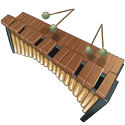|
 Here is a thread to discuss music theory, whether you want to know your majors from your minors, want to tell everyone about that cool new scale you just invented it's lydian dominant, or how to use a diminished seventh chord to pivot to literally any key. Or maybe you just want to shout "gently caress figured bass" into the abyss. This is a thread to cover any music theory discussion no matter how basic or advanced. Theory websites Chordinatr! is a Goon run website from Gruffalo Soldier, which allows you to see the relationships between chords, intervals and scales, and alter those to see how it changes things. Gruffalo Soldier posted:The top table allows you to set your scale, by flattening or sharpening each degree (relative to the major scale), and shows you the intervals from and to each other degree of the scale. The bottom table shows the chords that can be built from each degree. Two other websites which I see recommended a lot are Teoria and musictheory.net. Both are great at explaining everything from a very basic level, starting with beats, bars, note lengths, and going all the way through modes and cadences to neapolitan chords. If you have never even looked at written music before, those two websites will get you up to speed in no time. For more advanced users, musictheory.net has some great tools like one that lets you pick a chord and it shows you the notes in it, while Teoria has some exercises like giving you the name of a chord and telling you if you've written it on the stave correctly. Scales and Chord Tools is also a great website, if you've made up a funky chord, or started playing a weird melody and want to know what key it is in, plug the notes in and this website throws up possible chord names, scale names, modes, etc. YouTube channels This seems to be the best online resource now, because you can hear everything as it's being explained. 12tone This is my personal favourite channel. It has a great "Building Blocks" playlist to learn what scales and chords are, as well as videos analysing popular songs like Toto's Africa or Nirvana's In Bloom. But the real meat of this channel is the regular weekly theory videos going over such subjects as how to modulate to distant keys, microtonality, or unusual scales. Every video is short, concise, and no waffle, straight to the facts. Art Of Composing The "How To Compose Music" playlist is fantastic, and walks you through the basics of composing a small ternary form piece (ABA) using standard classical theory, including constructing sentences, functional harmony and modulations. There are some longer videos on there, and in some of those he answers questions or composes a piece of music live. He has a website, Art Of Composing with two paid courses, one of which is a far more in depth version of his YouTube course, and the other digs into writing an entire sonata. 8-bit Music Theory Very unique channel focusing on video game music. Analysing things such as the chord structures in Donkey Kong Country ambient music, or what exactly gives Mario its distinctive "fun" feeling. I don't think there's anything this in depth just for video game music. Adam Neely Quite popular channel, covering all sorts of music related stuff, not just theory, but has some really good theory videos, especially the "How To Not Suck At Music" playlist. Sideways Mainly focused on film and TV music, covering things like leitmotifs and how to evoke emotions in soundtracks. Michael New In depth videos on subjects such as extended chords, suspended chords, as well as covering basic stuff like circle of fifths and why we use sharps and flats. Uses a whiteboard and keyboard on screen to illustrate concepts. Signals Music Studios Mostly guitar based theory, but what he does isn't limited to just guitarists. Using interesting scales like Mixolydian b6, and a bunch of videos on great chord sequences which don't follow common practice. Rick Beato This guy is a monster. He covers everything in music, not just theory. Picks apart bands to work out why they're good, explains esoteric scales (Hungarian minor and Superlocrian bb7 in one video) and then writes a piece in every mode in that scale. Ear training, film music theory, jazz soloing. Anything you can think of and more. He also covers all sorts of mixing, business, performance, interviews with famous musicians, and other subjects too. Books I've seen "Fundamentals Of Musical Composition" by Arnold Schoenberg recommended a lot but haven't read it myself. I will get around to it soon! If anyone has anything to say about it, I'll add it to the OP. I'll be honest, I'm not sure which books are good, so if anyone has suggestions with a little writeup, again I'll add them to the OP. More Image at the top is a very basic representation of the usual chord progression of functional harmony (in a major key). Of course, rules are made to be bent and broken, but a good place to start is learning those rules in the first place. Art of Composing has a great explanation of functional harmony chord progressions in major and minor keys with detailed charts. Functional harmony is basically the concept that every chord has a function: tonic (I, vi), subdominant (ii, IV) or dominant (V, viio). Plus the weird uncle iii chord. Circle of fifths, very important, learn to play Hey Joe. Here is a very good post on Talk Bass detailing why it's important.  But we wouldn't be content with just a circle of fifths, so here is a circle of everything recommended by Helianthus Annuus:  If anyone knows any other resources they want added to the OP just post about it or PM me and I'll add it in. I'm definitely short on stuff about orchestration and jazz theory. And here is my own personal favourite video from 12tone, how to modulate to any key using a diminished 7th chord: https://www.youtube.com/watch?v=er6HLn6d05Y Konsek fucked around with this message at 22:29 on May 5, 2019 |
|
|
|

|
| # ? May 3, 2024 08:38 |
|
I'm nowhere near being good at this topic but I like it a lot, going to recommend some stuff I've used recently that has been extremely helpful. I mentioned in the other thread that I recently got the Hook Theory books. Book 1 is basic harmony and melody theory but the approach they take finally made a lot of stuff click for me, specially the concepts around progressions and chord inversions, I also got book 2 which goes into deeper topics such as 7th, 9th and 11th chords, borrowed and secondary chords and some more advanced progressions. A lot of it went over my head but I will revisit it until I fully grasp it. I recommend them both and they have a money back guarantee I think so no harm in trying them: https://www.hooktheory.com I had studied modes with my teacher when I took bass lessons but I never really internalized them until I watched this: https://www.youtube.com/watch?v=bwaeBUYcO5o&t=520s This guy's channel is great in general. I also like these channels Michael New https://www.youtube.com/user/Rhaptapsody Adam Neely https://www.youtube.com/user/havic5 And seconding the 12tone and 8bit music theory recommendations, both channels are awesome.
|
|
|
|
Seconding the recommendation for Adam Neely! After clunking around with only an extremely basic knowledge of theory, watching his channel inspired me to start delving in more. I'm still not very advanced (and not fast at all) but even just watching his Q&A videos provided a lot of jumping off points to start learning about concepts I was curious about but previously had no name for.
|
|
|
|
For non-classical theory and composition, I like the Berklee Press books, because they teach a ton without being overly dense, they're not expensive (at least compared to the Royal Conservatory) , and even more importantly, they come with audio samples. The only thing I dislike is their occasional tendency to get bogged down into what's "simply not done" (Berklee Jazz Harmony especially) but that might be an authorial trait.
|
|
|
|
I nearly added Adam Neely to the original OP but I wasn't sure since he has a lot of videos which are just fluff as well. If he's so popular I'll add him in. I've watched a few Michael New and Signals Music Studios videos before, I should look into them more deeply. So, originally this thread came from wanting to ask a question in the small questions thread. In rondo form, I've been trying to work out if the A sections need to be fairly identical each time. I had this idea of changing the underlying harmony (and slightly adjusting the melody to fit) for the middle A section of an ABACA rondo, but it sounds quite different, although recognisable. I suppose one answer is "if I like it that's all that matters", but I'd like to get a grip on accepted practice before I go too crazy. Analysing some Beethoven rondos, he never really changed the A section much, so I'm leaning towards that.
|
|
|
|
Yeah I think a good caveat for Adam Neely is that he does a lot of videos about music theory curiosities which, while very interesting, are not really very practical.
|
|
|
|
Konsek posted:I nearly added Adam Neely to the original OP but I wasn't sure since he has a lot of videos which are just fluff as well. If he's so popular I'll add him in. I've watched a few Michael New and Signals Music Studios videos before, I should look into them more deeply. I think you can go either way with it - I can't come up with any names at the moment, but I've heard it's not unusual to slightly alter the A sections. It's probably easier, starting out, to keep them pretty much the same until you get more of a feel for the form.
|
|
|
|
pffff composition and theory, what? in folk music all you need is I-IV-V and a relative minor (maybe, not even sure about that one). jk this is a great thread and i can't wait to wake up tomorrow and learn about diminished 7th chords.
|
|
|
|
Coohoolin posted:pffff composition and theory, what? in folk music all you need is I-IV-V and a relative minor (maybe, not even sure about that one). behold the only progression you need in music: I7 | I7 | I7 | I7 | IV7 | IV7 | I7 | I7 | V7 | IV7 | I7 | V7 I have it on good authority the only way to make authentic music is to play pentatonics over that progression
|
|
|
|
So are Diminished 7ths functionally like four different Dominant chords rolled into one depending on where you decide to go next with it in a progression? Cdim7: C - E♭ - G♭ - B♭♭ Resolves to: D♭ (functioning like an A♭7) E (functioning like a B7) G (functioning like a D7) B♭ (functioning like a F7) I know diminished sevenths are symmetrical, so each dim7 chord is essentially four equivalent dim7 chords, but is this basically the right way to view their function?
|
|
|
|
Know Such Peace posted:So are Diminished 7ths functionally like four different Dominant chords rolled into one depending on where you decide to go next with it in a progression? This might be what you're asking already, but they also behave like rootless 7b9 (if you take any dominant 7th grip on a guitar, and move the root up a semitone you've got a diminished seventh), so they can find use as a V7b9 in minor key harmony as well. So, yes. They also often get used as passing chords in diatonic harmony - something like Cmaj7 - C#o7 - Dm7 is not uncommon. They go the other way too, of course.
|
|
|
|
Yep. It can also act as a leading tone chord (viidim7 to I7 or imin7 where any note of the scale is acting as a I or i) or as a common tone (Imaj to idim7 to iimin7) it's freedom. basically you can go to just about anything with a diminished 7 chord.
|
|
|
|
Every genre benefits from diminished chords. Take your simple common metal progression [i-VI-VII]. Now follow that up with [V-VI-#vio-VII-#viio-i]. You got yourself some scandinavian power metal going. This just uses diminisheds, not 7ths, but drat those guys really are your swiss army knife. The thing is, tritones are huge dissonance and want to be resolved to something smoother. In a V7 chord the 3rd and 7th notes of the chord are a tritone apart and want to be resolved. Take the key of C Major. V7 chord is G7. So the 3rd note is B, wants to resolve up a semitone to C (1st note in the C major I chord). The 7th note, F, wants to resolve a semitone down to E, the 3rd note in the C Major I chord. Hey guess what other chord has those same notes? The viiø. Just to clarify, the viiø chord in a major key is half-diminished, not diminished, so the 7th is a semitone higher than a diminished chord, but the principle remains. similarly, the 1st and 3rd notes in the I chord are the 3rd and 5th notes in the vi chord. Now you can resolve to the relative minor, or a deceptive cadence as well. In minor keys, you get even more diminished 7th chords. One music teacher used to love telling the story that supposedly, Bach hated unresolved tritones. When he went to bed at night a relative would play a V7 chord on his harpsichord as a joke. Bach would have to get out of bed, run downstairs and play the I chord before he could get to sleep. Konsek fucked around with this message at 00:55 on Apr 14, 2018 |
|
|
|
I have a general question and a more specific question: General question: What's a good resource to learn more about minor key composition in the common practice style? Specific question: I've been working through Joe Stump's book on sweep picking, where basically every exercise mixes the natural and harmonic minor (I think this is a common practice thing?), and I'm very confused as to the logic behind some of the chord progressions. The one example that's throwing me really hard is: Ami - G#dim7 - Ami - G#dim7 - Ami - A*(?) - G*- C - F - Bb - E Or that's how it's notated in the book anyway, but since the A chord contains G, E, C#, A, I think it's really an A7. (The G arpeggio also has a flat seventh and so should be G7.) Question is: Why the gently caress does this -- especially the I7 in a minor key -- work?
|
|
|
|
i don't really get the logic of that progression, either. Am to A7 works as a temporary key change but the G7-C right after it doesn't really follow and then the rest is just a train wreck. I think he let his fingers do the thinking for him.
|
|
|
|
There's no logic to it that I could see, either. I've never seen Am to A7 like that, but a major-minor switch (A to Am) is or was fairly common as a IV chord. That obviously doesn't apply here. Still, if it works it works, and it doesn't always need to have an explanation in current music theory.
|
|
|
|
Any tricks to learn the chord inversions in roman numeral notation? Or do I just memorize that V4/3 is the V7 in second inversion and so on? I understand what the numbers represent but it's not really intuitive at first glance, less so in shorthand. Simone Poodoin fucked around with this message at 03:48 on Apr 16, 2018 |
|
|
|
Simone Poodoin posted:Any tricks to learn the chord inversions in roman numeral notation? Or do I just memorize that V4/3 is the V7 in second inversion and so on? The numbers are the intervals up from the root or inverted root: 6 is shortened from 6/3, which are the intervals of the triad in first inversion: E-G (third), and E-C (sixth). 6/4: G-C (fourth), G-E(sixth). I think 6 is shortened from 6/3 because it's easier to keep separate from 6/4 that way. Seventh chords, the same thing: First inversion is 6/5, shortened from 6/5/3: E-G (third), E-Bb (fifth), E-C (sixth); Second Inversion is 4/3, shortened from 6/4/3: G-B (third), G-C (fourth), G-E (sixth); and Third inversion is 4/2, shortened from 6/4/2: Bb-C (second), Bb-E (fourth), Bb-G (sixth). There's still memorization involved, but that's where the figured bass numbers come from, as far as I can tell.
|
|
|
|
Right, I understand where the numbers come from and I'm sure I can memorize them in time, I was just wondering if there was some mnemonic to memorize it more easily. The interval's significance is useful but not as much of an "a ha!" moment as the FACE trick for reading the staff for example. Or maybe it is and I just have to practice/internalize it a little bit more.
|
|
|
|
Unless I'm gravely mistaken, the inversions are in order: Root: V7 First Inversion: V6/5 Second Inversion: V4/3 Third Inversion: V4/2 or V2 Is this sort of notation ever used for unusual chord voicings, or is it pretty much exclusively used to notate inversions?
|
|
|
|
Simone Poodoin posted:Right, I understand where the numbers come from and I'm sure I can memorize them in time, I was just wondering if there was some mnemonic to memorize it more easily. Oh, right. As far as I know there's no handy mnemonic for that, no. For unusual voicings, this certainly can be used for that - what determines the inversion is entirely up to which chord tone is in the bass, and I'm pretty sure the chord can be in any order beyond that.
|
|
|
|
What is the argument for using that notation over slash chords?
|
|
|
|
At this point, there isn't really one; composers will sometimes use it for sketching out ideas apparently, and it has use in musical analysis (it's all over Piston's Harmony), so it can still be handy to know. It definitely has more of a classical application.
|
|
|
|
Yeah, musical analysis is the big thing afaik. Like, I64 chords have a different harmonic function than root position I chords, and it’s nice to be able to see it at a glance rather than have to check the key signature and the surrounding chords for context.
|
|
|
|
Bless this thread. I've been wanting to start experimenting with tone clusters ala Penderecki but I'm struggling to figure out how to actually use time. Anyone have any resources for how to implement tone clusters?
|
|
|
|
Cymbal Monkey posted:Bless this thread. I've been wanting to start experimenting with tone clusters ala Penderecki but I'm struggling to figure out how to actually use time. Anyone have any resources for how to implement tone clusters? a la Penderecki? I don't think I can help you there, he uses micro- and quarter-tones from what I'm seeing. I know a bit about them in a jazz-ish context, though.
|
|
|
|
Know Such Peace posted:Unless I'm gravely mistaken, the inversions are in order: I think that works well enough. I reread the chapter on 7th chord inversions in the hooktheory book and found out that I missed this table when I read it originally  Which says pretty much the same thing and it would be fairly easy to just memorize it like this with the help of the order
|
|
|
|
Jason Sextro posted:At this point, there isn't really one; composers will sometimes use it for sketching out ideas apparently, and it has use in musical analysis (it's all over Piston's Harmony), so it can still be handy to know. It definitely has more of a classical application. Ah, that actually makes some sense. Not sure I'll be making the leap though.
|
|
|
|
Anyone else ever play around with tritone substitution? It's one of my favorite compositional/improvisational tools! Basically, when you have a dominant chord in a ii-V7-I progression, you can substitute the V7 for a chord a tritone away. The reason for this is because the two most important notes of a chord, the ones that determine its quality, are the 3rd and 7th, and dominant chords are unique in that those two notes are a tritone apart. For example, look at the dominant chord in Dm7-G7-Cmaj. It's spelled G B D F, the 3rd and 7th being B and F, respectively. Interestingly, there is another dominant chord that contains B and F as the 3rd and 7th, except reversed. That would be C#7: C# E# G# B (E# and F are the same note). Because those two notes, the F and the B, still resolve in the same way from C#7-Cmaj as from G7-Cmaj, it's still a very strong sounding progression. In fact, it ends up being a chromatic descent, Dm7-C#7-Cmaj! Tritone sub is used real often in reharmonizations, and in my opinion they sound wonderful.
|
|
|
|
The Letter A posted:Anyone else ever play around with tritone substitution? It's one of my favorite compositional/improvisational tools! Tritone subs are cool, but they remind me tangentially of one my biggest (and growing!) pet peeves. You know it seems to be very difficult to find chord charts for original Tin Pan Alley songs? It's a lot easier to find reharmonizations where interesting harmonies have been replaced by frequently modulating ii-V-Is, over and over and over. It drives me absolutely crazy. There might come a time soon when people forget that rhythm changes were not, originally, a series of ii-V-Is in shifting keys; not at all, even. Speaking of rhythm changes, that bridge is fun to mix up with tritone subs.
|
|
|
|
Jazz mans love their ii-V-I progressions. Tritone substitutions are cool and good. A favourite thing of mine when playing 12 bar blues is on the fourth bar of I7, slip in a dominant 7th chord on the bV instead, before you go to the IV7 (so if you're in A major, play Eb7), this is the tritone sub of the V7/IV. Hell, instead of playing IV7 for 2 bars, make the second bar a #iv dim7 (IV7 chord but raise the root one semitone), which is enharmonic to i dim7, which commonly resolves to I. After that just go nuts with ii7-V7-I7 until you loop back round. Konsek fucked around with this message at 00:51 on Apr 22, 2018 |
|
|
|
My favourite 12-bar is actually Antonio Carlos Jobim's Wave, because you have to really squint to see it. It just goes to show that you can actually make it just about whatever you want to, yet very few seem to. I suppose it's a form best played as simply as possible with a Gibson guitar, and a few natural sixes thrown into a minor pentatonic mix for good measure.
|
|
|
|
Gotcha fam if you want me to explain rhythm/odd time signatures. (They're not nearly as complicated as they sound. Everyone just explains in a lovely convoluted way.) Basically if you know quarter notes eight notes and sixteenth notes you're good. it's the same basic masic. Something like say... 13/16, isn't any harder math-wise as 7/8, or 4/4... 4/4 is the same as 8/8. It's just only scored that way by dipshit composers though. So, 4/4 is 4 quarter notes. Which fits 8 eighth notes so. Think of 4/4 as 8/8 for a second. Take an eight note out. Boom. 7/8. Add one! 9/8! So 4/4 fits 4 quarter notes. Which fits 8 eighth notes. (Twice is fast as the quarter notes)! So of course there's 16 sixteenth notes! 4 times the speed of 8 notes. Twice as fast as the 8th notes. Anyway. 4/4 is also technically 16/16. Take a sixteenth note out! 15/16! Add some! 19/16! But anything x/16 is pretty rare. Also odd numbers on the bottom apparently exist, but that's silly mental gymnastics where you express it on paper with an even number on bottom. Also Hey Ya! is basically in 4/4 with a 2/4 "turnaround" measure every phrase. Very clever. 6 bar pattern. 3 bars of 4/4, that bar of 2/4, two more bars of 4/4...And repeat. Anyone who calls it 11/4 has definitely not looked at sheet music before lol. Anyway! Riddims are theory? fartzone_42069 fucked around with this message at 15:05 on Apr 22, 2018 |
|
|
|
On that note, here's a really cool video about South Indian rhythmic solfege: https://www.youtube.com/watch?v=KsvKQhOeQjQ I'm not sure I'll ever use it, but it's drat cool.
|
|
|
|
fzA455 posted:Basically if you know quarter notes eight notes and sixteenth notes you're good. it's the same basic masic. Something like say... 13/16, isn't any harder math-wise as 7/8, or 4/4... To make 7/8 have its own character, instead of sounding like an abbreviated 4/4, you can think it in groups of twos and threes. This will give you three unique characters to choose from: 2+2+3, 3+2+2, and 2+3+2. Here's an example of 11/8 grouped as 3+3+3+2, fzA455 posted:Also odd numbers on the bottom apparently exist, but that's silly mental gymnastics where you express it on paper with an even number on bottom.
|
|
|
|
Loving the rhythm chat, even if I have nothing to add. Just wanted to say I added some more YouTube channels to the OP.
|
|
|
|
ah yes, Beato is fantastic. I really enjoy the "What Makes This Song Great" series he does
|
|
|
|
I don't think music theory is real. You expect me to believe that all these squiggly symbols mean anything?
|
|
|
|
Jazz Marimba posted:This is a great way to introduce someone to odd time signatures, but using only this method of thinking about time signatures makes all your music/playing sound like the time signature you're thinking of with a subdivision added or removed, instead of sounding like that time signature itself, e.g. your 7/8 would sound like 4/4 missing an 8th like in The Ocean by Led Zeppelin. Oh I know. I guess I was explaining the math. Odd times are often broken into counting/accent patterns, true. I tend to do what I want though! quote:Non-diadic time signatures are just as simple as any other time signature, we just weren't exposed to them in 5th grade so they seem weird, obtuse, and/or unnecessarily complex. Here's a decent explanation of them, and I can help clarify further if you want. I see. That link was about tonal stuff (gross). Looked up Non-diadic time. I'll try to find examples when I'm done with work. My suspicion is it's crap written in an overcomplicated manner to mess with students' heads.
|
|
|
|

|
| # ? May 3, 2024 08:38 |
|
fzA455 posted:I see. That link was about tonal stuff (gross). Looked up Non-diadic time. I'll try to find examples when I'm done with work. My suspicion is it's crap written in an overcomplicated manner to mess with students' heads. It's actually not! Say we're playing a song that's in 4/4 and the verse are straight 8ths, but the choruses are going to be 5/12. This means each measure of the verse is divided into 4 (or 8) equal parts, and each measure of the chorus is divided into 5 equal parts based on...what? To determine how this feels/sounds, divide the measure into 12 equal sections, e.g. 12/8 but with the same downbeats, then count only five of them: 1ea2e|1ea2e| etc. We can't notate this as 5/8 or 5/16 because 5/8 is five notes over just little longer time, and 5/16 is five notes over just a little less time. It's the time signature equivalent of people playing dotted 8th, dotted 8th, 8th instead of quarter note triplets. Of note: non-diadic time signatures are felt in relation to diadic time signatures, so having a song entirely in 5/12 is just adding another time signature to the "it's in 5/8 || no it's a fast 5/4 || no it's a slow 5/16" debate.
|
|
|





















